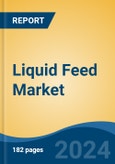Speak directly to the analyst to clarify any post sales queries you may have.
10% Free customizationThis report comes with 10% free customization, enabling you to add data that meets your specific business needs.
The global liquid feed market is driven by several key factors. Rising demand for high-quality animal products, a focus on animal health and welfare, technological advancements in feed manufacturing, and the adoption of precision farming practices are among the primary drivers. Additionally, the market is influenced by trends such as sustainability, customization of feed solutions, and the incorporation of digital technologies in livestock management.
Key Market Drivers
Rising Demand for High-Quality Animal Products
The rising demand for high-quality animal products serves as a pivotal market driver propelling the growth of the global liquid feed market. This trend is driven by several interconnected factors that influence consumer preferences, economic conditions, and the overall dynamics of the livestock industry. The global population is steadily increasing, leading to a growing demand for animal products such as meat, milk, and eggs. As economies develop, dietary preferences often shift towards protein-rich diets, further intensifying the demand for livestock products. Consumers are increasingly seeking high-quality, nutritious animal products, influencing farmers and producers to adopt advanced nutritional strategies, including the incorporation of liquid feed into animal diets.Economic prosperity in various regions has resulted in higher disposable incomes for consumers. This financial stability allows individuals to afford premium and high-quality food products, including animal products. As a result, there is a shift in consumer expectations towards healthier and more sustainably produced meat and dairy items. Livestock producers respond to this demand by investing in technologies such as liquid feed to optimize animal nutrition and improve the quality of the final products. Liquid feed is recognized as a valuable tool for nutritional enhancement in animal diets.
Livestock producers acknowledge the importance of providing animals with balanced and optimized nutrition to achieve better growth rates, higher milk yields, and improved meat quality. Liquid feed formulations can be customized to address specific nutritional deficiencies, ensuring that animals receive the required nutrients for optimal health and productivity. This focus on nutritional precision aligns with the demand for high-quality animal products in the market.
Molasses is a standout ingredient in liquid feed due to its palatability and high energy content. Molasses-based liquid feeds are particularly valued for improving ruminant digestion, which in turn boosts productivity in cattle and sheep. Another significant ingredient, especially in North America, is corn-steep liquor. Corn-based liquid feeds provide a crucial energy source, promoting weight gain and milk production in livestock.
Key Market Challenges
Cost Factors and Affordability
The production and utilization of liquid feed can be associated with higher costs compared to traditional dry feed alternatives. Liquid feed often involves specialized manufacturing processes, storage facilities, and transportation considerations, all of which contribute to increased production costs. Additionally, the procurement of high-quality ingredients and additives for liquid feed formulations can be expensive. Affordability becomes a significant concern for farmers, especially those operating on tight profit margins. The perceived higher cost of liquid feed may hinder its widespread adoption, particularly in regions where economic constraints are a significant consideration for livestock producers.Key Market Trends
Increasing Emphasis on Sustainable Livestock Production
There is a growing global awareness of the environmental impact of livestock production, including concerns related to animal Type use, greenhouse gas emissions, and waste generation. As a result, the liquid feed market is witnessing a trend toward sustainability. Liquid feeds, with their potential to improve feed efficiency, reduce waste, and enhance nutrient utilization, align with the goals of sustainable agriculture. Producers are increasingly adopting liquid feeds as part of a broader strategy to minimize the ecological footprint of livestock farming. This trend is driven by both consumer demand for ethically produced and environmentally friendly products and regulatory initiatives promoting sustainable practices.Key Market Players
- Archer Daniels Midland Company
- BASF SE
- Bundaberg Molasses
- Alliance Liquid Feeds Inc.
- Cargill Incorporated
- Dallas Keith Ltd
- GrainCorp Limited
- Land O'lakes Inc.
- Ridley Corporation
- Masterfeeds LP
Report Scope:
In this report, the Global Liquid Feed Market has been segmented into the following categories, in addition to the industry trends which have also been detailed below:Liquid Feed Market, By Type:
- Proteins
- Minerals
- Liquid Feed
- Others
Liquid Feed Market, By Ingredients:
- Molasses
- Corn
- Urea
- Others
Liquid Feed Market, By Animal Type:
- Ruminants
- Poultry
- Swine
- Aquaculture
- Others
Liquid Feed Market, By Region:
- North America
- United States
- Canada
- Mexico
- Europe
- France
- United Kingdom
- Italy
- Germany
- Spain
- Asia-Pacific
- China
- India
- Japan
- Australia
- South Korea
- South America
- Brazil
- Argentina
- Colombia
- Middle East & Africa
- South Africa
- Saudi Arabia
- UAE
Competitive Landscape
Company Profiles: Detailed analysis of the major companies present in the Global Liquid Feed Market.Available Customizations:
With the given market data, the publisher offers customizations according to a company's specific needs. The following customization options are available for the report.Company Information
- Detailed analysis and profiling of additional market players (up to five).
This product will be delivered within 1-3 business days.
Table of Contents
Companies Mentioned
- Archer Daniels Midland Company
- BASF SE
- Bundaberg Molasses
- Alliance Liquid Feeds Inc.
- Cargill Incorporated
- Dallas Keith Ltd
- GrainCorp Limited
- Land O'lakes Inc.
- Ridley Corporation
- Masterfeeds LP
Table Information
| Report Attribute | Details |
|---|---|
| No. of Pages | 180 |
| Published | March 2025 |
| Forecast Period | 2024 - 2030 |
| Estimated Market Value ( USD | $ 57.14 Billion |
| Forecasted Market Value ( USD | $ 79.15 Billion |
| Compound Annual Growth Rate | 5.5% |
| Regions Covered | Global |
| No. of Companies Mentioned | 10 |









